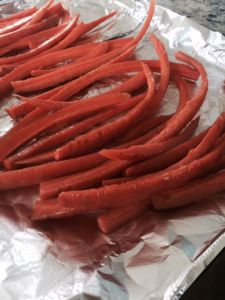Loving the BITE: Carrot Fries are the Next Big Thing
 Move over sweet potato fries. Carrot fries are the next big thing – mark my words. Why? They are inexpensive, super easy, incredibly nourishing, and oh-so delicious. This week, we’ll keep it easy with the how and why of scrumptious carrot fries.
Move over sweet potato fries. Carrot fries are the next big thing – mark my words. Why? They are inexpensive, super easy, incredibly nourishing, and oh-so delicious. This week, we’ll keep it easy with the how and why of scrumptious carrot fries.
Recipe of the Week: Delicious Carrot Fries
Ingredients:
- 8 carrot
- 1-2 Avocado oil, to drizzle
- 1/2 tsp Garlic Powder
- Salt, to taste
- Pepper, to taste
Instructions:
- Pre-heat oven to 400 deg. F.
- Chop carrots into long fries by first cutting carrot in half cross-wise, then quartering lengthwise. If you’re able to get them even thinner, or when using large carrots, it’s better – so shoot for 12 fries per carrot.
- Place carrots on cookie sheet.
- Drizzle with oil. Sprinkle on garlic powder, salt, and pepper.
- Bake for 15-20 minutes, turning over half-way through cooking.
- Serve warm or cooled.
Comments:
Despite what you may have heard about carrots being too high in carbs and sugar, I go out of my way to look for opportunities to add them to my and my family’s meals (I’m not sure in what world 5 grams carbs per 1 medium carrot – with 2 of those grams being fiber – is too high, but I digress). Here’s why:
Carrots: As a inexpensive superfood vegetable, carrots have A LOT to offer cyclists. They contain:
- Carotenoids: Along with spinach and pumpkin, carrots are among the kings of carotenoids. Specifically, carrot contain the super antioxidant, beta-carotene. As most of us know even from early childhood, carrots and high blood beta-carotene levels are good for your eyes, specifically the prevention of glaucomas a we age.
- Polyacetylenes as an anti-cancer agent: The polyacetylenes found in carrots inhibit colon cancer cell growth. In fact, the polyacetylenes and carontenoids in carrots seem to work together to reduce these growths, with the carontenoids protecting the nutrients in the carrots (antioxidant action for the polyacetylenes) and our own cells.
- Cardiovascular Health Protection: A recent 10-year study from the Netherlands has shown a strong correlation between carrot intake and reduction in cardiovascular risk. In fact, carrots emerged as one of the most potent cardiovascular health benefactors among fruits and vegetables.
- Healthful Nutrients: Beyond it’s unique healthful qualities, carrots also provide Vitamin C, B Vitamins, minerals such as copper, calcium, potassium, manganese and phosphorus, and fiber. Carrots are incredibly easy to add to any eating plan, easy to pack, and doesn’t need any special prep (just wash and eat without peeling!).
And these carrots, when paired with a protein and side salad, make a great “Light at Night” side. Here’s the details:
- Proteins: At dinner, include a good protein source such Organic Ground Meat, Fish, Beans, Quinoa, Eggs, Seeds, or Nuts. Protein at dinner can further decrease any muscle wasting, encourage muscle repair and rebuilding, and reducing spikes in blood sugar/insulin. Especially if you’re training earlier in the day, make sure to include protein at dinner.
- Vegetables: Dark Lettuce Leaves, Tomatoes, Broccoli, Bell Peppers, and more make for great salads (or make sauted or grilled vegetables). Then, add these carrot fries on the side for even more delicious nourishment. Vegetables are a great source of antioxidants that supports cellular repair and decreases the oxidative stress that’s often elevated from training.
- Healthy Fats: Avocados, avocado oil, olive oil (on a salad), coconut oil, nuts, and seeds can be healthy fat sources at dinner. These fats promote overall wellness and good hormone balance without increased blood sugars.
- Carbohydrates: Why not grains and other carbohydrates? While I think it’s fine to include these occasionally, if you’re actively trying to lose fat, keep it to just 2 dinners or so a week. Carbohydrates are simply not needed by the body in the evening if you’re relaxing, and serve only as an extra calorie source. They promote increased insulin levels, which promotes fat storage, especially when they are not readily used (as they would be immediately before, during, or after training). They are often inflammatory in the body, especially if they are refined grains or sugars (refined grains act very similarly to sugars in the body). What’s more, the extra insulin output can interfere with hormones that are released at night and work to promote optimal muscle repair and recovery. Bummer!
Of course, there are exceptions to every rule. Proactively add carbs back in, around 30 grams or so, when it’s the evening before an extra strenuous or long ride the next day (or if you’re using dinner as a recovery immediately after an evening training). Thirty grams of carbs is the equivalent of 2/3 cup cooked brown rice, quinoa, or beans, 1 large banana, 1 medium sweet potato, 1 cup whole-grain pasta, 1 1/2 cup fruit, 8 oz. chocolate milk, etc.
I’m predicting it now: Pinterest, Foodie Blogs, and even restaurants will soon serve up carrot fries! Why not? If it tastes good, they will come.
Fuel Your Ride. Nourish Your Body.
If you’d like to work with Kelli one-on-one with a Custom Nutrition Plan & Coaching, or download one of her acclaimed Instant Download Plans like Fuel Right Race Light, click here: Apex Nutrition Plans for Endurance Athletes. Be sure to use coupon code lovingthebike for a 15% discount!


